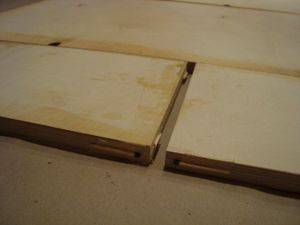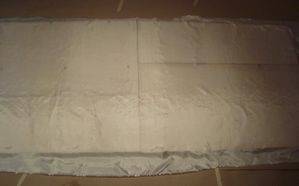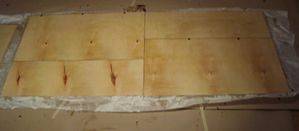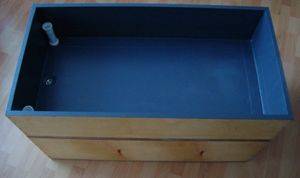kaljukajakas
Active member
I wanted a 20" wide by 40" long by 12" high reservoir and an 8" high table to fully use the space in my cabinet. I couldn't buy one so I decided to build it. One that would last for a good many years.
First of all, I got some 3/4" exterior grade plywood, which was cut up. Then the edges were painted with polyester resin, cured, and covered with masking tape. Some matches were used as spacers between the pieces for the next step.


The masking tape and matches are needed to keep the plywood panels from sticking to each other and getting the edges messy when several panels are covered with fiberglass side-by-side. I used polyester resin. Just laid out some panels, stretched some fiberglass cloth over them and worked in the resin with a squegee. Covering plywood with fiberglass while the boxes are assembled would have been a real PITA. You'd end up a mess of frayed fibers that stick everywhere, the fiberglass pieces would slide about etc...


Then the excess cloth was cut off with a sharp knife, the masking tape was removed and the pieces were glued together with epoxy and then screwed together as the glue was curing. The fiberglassed side is of course the interior. Fiberglassing the exterior didn't seem necessary.

If enough epoxy was used the boxes will already be watertight. To make them even more watertight I applied 4" wide seam reinforcement tape to the interior corners. First I painted the corners with polyester resin, then applied the tape so it stuck immediately and then brushed on some more resin to saturate the tape. Then I also painted the exterior of the boxes with resin and gave the entire interior an extra coat.

Next three holes were drilled in the table and E&F fittings were installed. Just some 1 1/2" sewer pipes that slide up and down inside two female pieces set into the table for double overflows and a drain from a sink for the pump. Again, lots of resin makes everything waterproof. I used about a gallon of resins (epoxy and polyester) for the entire build.


Finally a couple of coats of dark grey potable epoxy paint on all surfaces that come in contact with water as a finishing touch.


First of all, I got some 3/4" exterior grade plywood, which was cut up. Then the edges were painted with polyester resin, cured, and covered with masking tape. Some matches were used as spacers between the pieces for the next step.
The masking tape and matches are needed to keep the plywood panels from sticking to each other and getting the edges messy when several panels are covered with fiberglass side-by-side. I used polyester resin. Just laid out some panels, stretched some fiberglass cloth over them and worked in the resin with a squegee. Covering plywood with fiberglass while the boxes are assembled would have been a real PITA. You'd end up a mess of frayed fibers that stick everywhere, the fiberglass pieces would slide about etc...
Then the excess cloth was cut off with a sharp knife, the masking tape was removed and the pieces were glued together with epoxy and then screwed together as the glue was curing. The fiberglassed side is of course the interior. Fiberglassing the exterior didn't seem necessary.
If enough epoxy was used the boxes will already be watertight. To make them even more watertight I applied 4" wide seam reinforcement tape to the interior corners. First I painted the corners with polyester resin, then applied the tape so it stuck immediately and then brushed on some more resin to saturate the tape. Then I also painted the exterior of the boxes with resin and gave the entire interior an extra coat.
Next three holes were drilled in the table and E&F fittings were installed. Just some 1 1/2" sewer pipes that slide up and down inside two female pieces set into the table for double overflows and a drain from a sink for the pump. Again, lots of resin makes everything waterproof. I used about a gallon of resins (epoxy and polyester) for the entire build.
Finally a couple of coats of dark grey potable epoxy paint on all surfaces that come in contact with water as a finishing touch.

Last edited:







